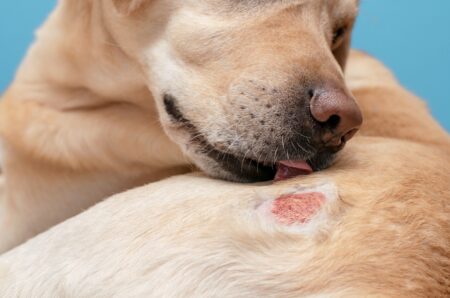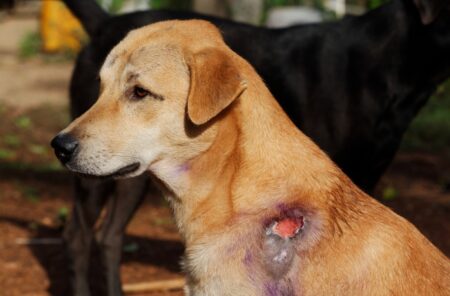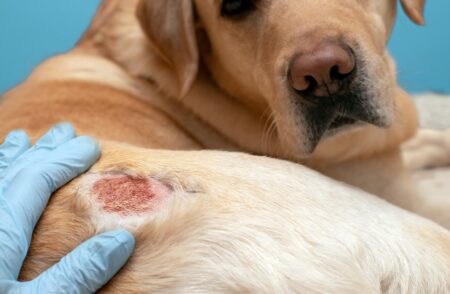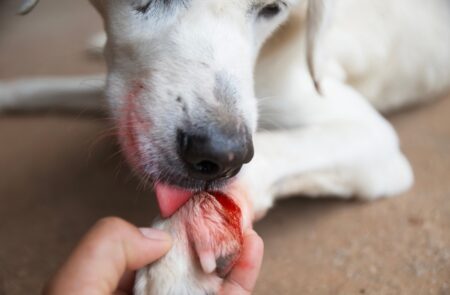Dog Wound Healing Stages Pictures
Dog wound healing stages pictures provide valuable insight into the healing process after a pet has been injured. It is important to note that the healing process is divided into five distinct stages, which vary based on the severity of the wound. While it is not possible to see the entire process in pictures, these pictures demonstrate the stages at which the wound is present. Thus, understanding them can help owners monitor the healing process and determine whether additional treatments are necessary.
Dog Wound Healing Stages Pictures
- Stage 1: Hemostasis – Dogs need to form a clot in order to stop the flow of any bleeding. This is the first step of the wound-healing process. This can be done by using pressure, medications, and antibiotics.
- Stage 2: Inflammation – This stage is marked by inflammation, increased heat, swelling, and redness of the area of the wound. This is caused by the release of molecules such as histamine and prostaglandins, which act to attract white blood cells and other immune system cells to the wound area.
- Stage 3: Formation of Granulation Tissue- The body must create a new surface to replace the skin that has been destroyed by the wound. This is done by the formation of granulation tissue, where vascular structures, collagen, and fibroblast cells form a new layer.
- Stage 4: Maturation – The newly formed granulation tissue matures, increasing strength and tissue stability. During this stage, the wound’s edges will move closer together and the wound will heal completely.
- Stage 5: Remodeling – This final stage of healing involves the construction of new, strong skin, as the wound finally closes and the area is repaired.
What Is A Wound?
A wound is an injury to the skin or to any other external or internal body part that is marked by tearing, breaking, or puncturing of skin and underlying tissues. Wounds can be caused by external forces such as cuts, blows, and accidents, or they can be caused internally due to conditions such as ulcers, inflammation, or diseases.
Common Types of Wounds in Dogs
- Abrasions: Abrasions are common superficial wounds in dogs that are caused by friction or rubbing of the skin, usually caused by the animal rubbing against a hard surface or object.
- Lacerations: Lacerations are tearing wounds caused by the animal coming into contact with something sharp, or objects tearing through their skin, such as bites, claw wounds, barbed wire, and other sharp objects.
- Puncture Wounds: Puncture wounds are caused by a sharp object piercing the dog’s skin, such as a nail, stick, or animal tooth or claw.
- Hot Spots: Hot spots are red, weeping, and irritated patches of skin on dogs that result from a bacterial or fungal infection and require medical treatment.
- Ticks & Fleas: Ticks are parasitic insects that feed on their host’s blood and can cause anemia, fever, and swollen lymph nodes in dogs if the infestation is left untreated. Fleas bite dogs and can cause intense itching, hair loss, and allergic reactions.
- Burns: Burns are caused by extreme heat, fire, electricity, and various chemicals and may range from first-degree to third-degree.
SEE ALSO: My Pet Died And I Can’t Stop Crying
What You Should Include in Your Doggie First Aid Kit
- Gauze padding and adhesive tape or Vet Wrap
- Tweezers and scissors
- Cotton swabs
- Individually packaged alcohol wipes
- Sterile Non-adhesive dressings
- Icepack
- Towel or blanket
- Benadryl
- Mineral oil
- Electrolyte powder
- Petreyling (can be purchased over the counter)
- An Eye-dropper and a small syringe
- Horn of Antibiotic Ointment
- Pet first aid book or guide
- Disposable gloves
- Nail clippers
- Eye lubricant
- Styptic powder
- Rescue Remedy
- Flashlight (for use in the dark or illuminations of wounds/areas)
What Warning Signs to Look for at This Healing Stage of a Dog Wound:
- Discoloration – Deep red or purple/blue areas around the wound may indicate swelling, infection, or slow healing.
- Increased Discharge – An increase in fluid oozing from the wound could be an indicator of an infection.
- Severe Itching or Pain – Unusual or intense itching or pain associated with the wound area could indicate an allergic reaction or infection.
- Odor – A foul odor from the wound may signal infection.
- Fever – A fever may indicate systemic infection.
What Factors Affect the Rate of the Healing Stages of a Dog Wound?
- The size and depth of the wound: Larger wounds typically take longer to heal, and also wounds that are deeper require more time for proper healing.
- The age of the dog: Older dogs will usually take longer to heal because they have a weaker immune system than younger dogs.
- The health of the dog: A healthy dog will be able to heal faster as their body will be able to produce more of the necessary molecules and hormones for wound healing.
- The location of the wound: Wounds located in more sensitive areas or those which are exposed to the elements will take longer to heal.
- The type of wound: Wounds caused by deeper penetrating objects such as bullets, or wounds that become infected, will take longer to heal, compared to minor scrapes and cuts.
- Proper wound care: The way the wound is cleaned, treated, and dressed will play a role in the healing process, so proper wound care is important to ensure that the wound heals properly.
How To Care for a Dog Wound
- Stop the Bleeding: If the wound is bleeding, try to stop it first with a pressure bandage or gauze. Hold a clean cloth or towel firmly over the wound.
- Clean the Wound: Clean the wound with water and mild soap. Use a clean cotton swab or clean gauze to gently wipe away any dirt or debris. Rinse with clean water.
- Apply an Antibacterial Ointment: Apply an antibiotic ointment to the wound to help prevent infection.
- Cover the Wound: Cover the wound with clean gauze or other dressing over the area to protect it from dirt, debris, and further damage.
- Monitor the Wound: Monitor the wound for signs of infection such as swelling, redness, increased pain, and/or discharge.
- Consult a Veterinarian: If the wound does not seem to be healing or if there is any sign of infection, consult your veterinarian for further advice.
How to Heal A Dog Wound Fast
- Clean the wound. Start by cleaning the wound and removing any debris. Use a gentle cleanser like warm salt water or mild soap and water. Do not use hydrogen peroxide or iodine on open wounds.
- Stop the Bleeding. Gently apply firm pressure to the wound with a sterile gauze pad or sterile cotton. Apply for a full five minutes.
- Apply an antimicrobial ointment or topical antibiotic. Now that the wound is clean, it’s time to treat it with an antimicrobial ointment or topical antibiotic to prevent bacterial infection.
- Cover the wound. If the wound is deep or prone to infection, cover it with a non-stick dressing. Change the dressing every other day or as needed.
- Monitor the wound regularly. Monitor the wound daily to make sure it is healing properly. If at any point, the wound appears to be getting worse, please seek veterinary care.
Dog Wound Healing Time
Dog wound healing time varies depending on the severity and location of the wound. Generally, minor puncture wounds can heal in a few days, while larger lacerations might take weeks to heal. The exact amount of time depends on the type of wound, the dog’s age, and overall health. Younger dogs tend to heal faster than older dogs, and factors like poor nutrition, chronic disease, and immune disorders can slow healing. Dogs with managed medical conditions and proper nutrition have a better chance of recovering quickly.
Open Wound On Dog Won’t Heal
Open wounds on dogs may be caused by infection, trauma, or complications from surgery, among other things. If your dog’s open wound isn’t healing properly, it’s important to seek veterinary care to try to address the underlying cause of the wound. It’s possible that the underlying cause of the wound is contributing to the wound’s difficulty in sealing. This could include an infection, foreign body, or other underlying skin problem. The attending veterinarian can help to properly diagnose and treat the underlying cause, which will help the wound heal better. Your veterinarian may also give you tips on how to care for the wound while you wait for it to heal. If the wound is not healing with regular treatment, your veterinarian may recommend additional therapies such as antibiotics, wound dressings, or surgery.
How Do You Know If Your Dog’s Wound Is Healing?
There are a few signs of a healing wound:
- The wound appears smaller or is shrinking in size.
- The wound appears to have less inflammation, redness, tenderness, crusting, and swelling.
- The edges of the wound appear to be closing or healing together.
- The wound is no longer actively bleeding.
- The surrounding skin looks healthy and intact.
- New hair is growing around the wound.
How To Heal A Dog Wound Fast At Home
- Clean the wound: This should be done with clean water and mild antiseptic soap. Use a clean cloth or gauze to gently remove any dirt and remove debris from the wound.
- Apply an antiseptic ointment: After cleaning the wound, apply an antiseptic ointment to protect the wound from further infection.
- Cover the wound: Place a clean bandage or sterile gauze over the wound to protect it from further harm and contamination.
- Monitor the wound: Pay close attention to the wound and watch for signs of infection such as increased redness, swelling, or discharge. If you see any of these signs, take your dog to a veterinarian for further treatment.
- Feed a nutritious diet: Giving your dog a healthy and nutritious diet can help to speed up the healing process.
Tips to Speed Up Dog Wound Recovery
- Keep the wound clean: The most important aspect of speeding up dog wound healing is to keep the wound clean. This is especially important if the wound is open or there are signs of infection. Gently clean the area with a mild antiseptic solution, then apply a sterile dressing and change it frequently, at least twice a day.
- Use a wound cover: There are various styles of products available that help wounds heal faster, such as canine wound covers. By keeping the wound covered, the germs and infection-causing agents are kept away from the wound.
- Proper nutrition: A proper diet plays an important role in healing. A diet high in protein and fresh fruits and vegetables encourages the proper growth of cells, aiding in tissue repair.
- Provide a balanced diet to ensure your dog gets all the nutrients to aid recovery.
- Exercise: Exercise helps keep an animal in shape and encourages proper circulation. Once your pet is cleared to exercise, provide regular walks, play, and swims. This helps the body heal faster, by increasing blood flow to the area and promoting the proper growth of cells.
- Provide TLC: Spend time with your dog cuddling, socializing, and playing.
SEE ALSO: Why Does My Dog Sleep On Me?
FAQ
Q. What is the fastest way to heal a dog wound?
A. The fastest way to heal a dog wound is to first clean it with a diluted solution of salt water or hydrogen peroxide. Then apply a topical antibiotic cream and a bandage to the wound. Additionally, provide your dog with plenty of rest and time for the wound to heal. Finally, contact your veterinarian for further support and advice.
Q. How long does it take for a dog wound to close?
A. The time it takes for a wound to close depends on the size and type of wound and the health of the dog. Generally, small superficial cuts may close in a few days or less while deeper wounds and lacerations can take anywhere from several days to a few weeks.
Q. Does a dog licking your wound help it heal faster?
A. No, a dog licking your wound will not help it heal faster. In fact, excessive licking or biting of the wound can cause irritation and even infection. It is best to clean the wound with soap and water, cover it, and seek medical treatment.
Conclusion
The dog wound healing stages pictures are a helpful visual tool for pet owners and veterinarians alike, to monitor the progress of wound healing in their canine patients. It provides an indication of the various stages that a wound may go through: wounds that are in the inflammation and healing phase, those that are in the maturation phase, and those that are healed or scarred over. By understanding the stages of wound healing for a dog, pet owners, and veterinarians can provide better care and prevent further complications.


